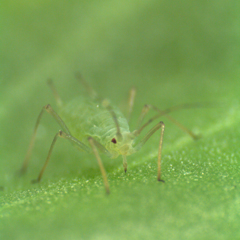Coral Gables, FL (February 23, 2010)—For the first time, scientists have sequenced the entire genome of the pea aphid, a notorious horticultural and agricultural pest. The findings reveal the extent of the genetic collaboration of the aphid host with its bacterial symbiont, which may account for some of the extraordinary characteristics of this insect.
Aphids are among the first insects to appear in early spring on crops. They possess incredible adaptive abilities, and under optimal conditions, reproduce very rapidly. They live by sucking the juices of plants, and if left untreated they can cause plant death. All this means trouble for growers. Annual global crop losses associated with aphids run at hundreds of millions of dollars.
"The most important direct benefits to society from this project will come from the way the project increases our ability to understand the ways that aphids interact with their host plants, the plant viruses they transmit, and their bacterial symbionts. These aspects of aphid biology directly impact food supply and pesticide use," says Alex Wilson, assistant professor of biology at the University of Miami College of Arts and Sciences, and representative for the Americas on the Board of the International Aphid Genomics Consortium, who also serves as member of the project leadership team.
The new study by the International Aphid Genomics Consortium uncovers some of the best-kept secrets of this amazing creature. The study entitled "Genome Sequence of the Pea Aphid Acyrthosiphon pisum" was published online today by PLoS Biology. Genomic analysis of the pea aphid and its bacterial symbiont, Buchnera aphidicola, implicates extensive collaboration between the two partners.
 Photo credit: Tania Wyss, Wilson Lab, Department of Biology, University of Miami.
Photo credit: Tania Wyss, Wilson Lab, Department of Biology, University of Miami.
The pea aphid is the first sap sucking insect to have its genome sequenced. Fascinating facts about aphids include that they are able to reproduce both sexually and asexually, that genetically identical individuals can be winged and wingless, lay eggs and bear live young. Development includes a telescoping of generations, such that a female carries the embryos of both her daughters and her granddaughters.
"We found that the interaction of the pea aphid with its bacterial symbiont is far more intimate than anyone had previously envisioned," says Wilson. "We hypothesize, based on the genome sequence that they each compensate for the evolutionary loss of genes by shuffling essential metabolic products between them. Gene loss between the two partners is so extensive that neither one can live without the other."
Pea aphids are small, with adult sizes ranging from 4-5 mm, and are green or pink in color. They have amazing plasticity. Whenever overcrowding occurs; an aphid colony will produce winged females that migrate to establish new colonies in other areas. Able to reproduce both sexually and asexually, aphid populations can increase in size at exponential rates: when asexual females are pregnant, their embryos are also pregnant, so females can carry both their daughters and granddaughters, a condition called telescoping of generations.
The sequencing of the pea aphid genome, funded by the National Human Genome Research Institute, resulted from a collaboration between a team at the Baylor College of Medicine led by Dr. Stephen Richards and the International Aphid Genomics Consortium, a diverse group of investigators who work together to advance understanding of the genome biology of the aphid. This study has engaged 200 scientists from 16 countries in advancing research on an insect of scientific, economic and agricultural importance. "Having a genome opens up our world. Anything is now possible," says Wilson. "The genome provides the foundation. Now the hard work begins."
Source: University of Miami